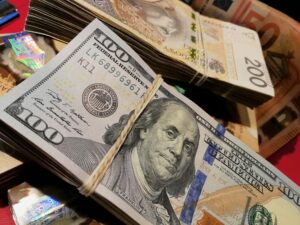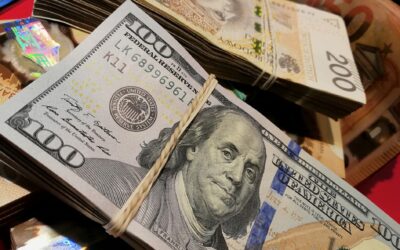Dollar attracts most interest in forex trading
The value of the US dollar is measured in three ways: exchange rates, government bonds and foreign exchange reserves. While the most common method is through exchange rates, the truth is that you need to be familiar with all three to be able to make good guesses about where the dollar might go in the future and make money from it. The dollar attracts the most interest in forex trading.
Exchange rate
This is the dollar exchange rate compares its value with the currencies of other countries. It allows you to determine how much of a particular currency you can exchange for a dollar. The most popular exchange rate measurement is the US Dollar Index. These rates change every day as currencies are traded on the foreign exchange market. The currency’s exchange value depends on several factors, including: – Central bank interest rates – Country debt levels – Strength of the economy When these factors are strong, the currency’s value is also strong. Most countries have a flexible exchange rate and allow currency traders to determine the value of their currencies. The Federal Reserve has many monetary tools that can affect the strength of the dollar. These tools allow the government to regulate exchange rates, albeit indirectly. The US dollar exchange rate shows the value of the dollar in comparison to other currencies, including the Indian rupee, Japanese yen, Canadian dollar and the British pound. This chronology explains some of the dollar’s value changes over the years: – 2002-07: The dollar fell by 40% as US debt grew by 60%. In 2002, one euro was worth $0.87 against $1.46 in December 2007. – 2008: The dollar strengthened early in the global financial crisis thanks to its status as a “safe haven” for many investors, among other factors.1 By the end of the year, the euro was worth $1.35. – 2009: The dollar fell by 20% thanks to debt fears. In December, the euro was worth $1.46. – 2010: The Greek debt crisis hurt the euro and strengthened the dollar.2 By the end of the year, the euro was worth just $1.32. – 2011: The value of the dollar against the euro fell by 10%. It regained ground later. As of December 30, 2011, the euro was again worth $1.32. – 2012: At the end of 2012, the euro was still around $1.32. – 2013: The dollar lost its value against the euro, as at first it seemed that the European Union was finally resolving the eurozone crisis. In December it was worth $1.37. – 2014: The euro-dollar exchange rate fell to $1.23 thanks to investors fleeing the euro. – 2015: The euro-dollar exchange rate fell to a low of $1.12 in March. It later fell to $1.05 after the Paris attacks in November, before ending the year at $1.08. – 2016: The euro rose to $1.13 on February 11 as the Dow fell to a stock market correction. It fell further to $1.11 on June 25, just two days after Britain voted to leave the European Union. Traders believed that the uncertainty surrounding the vote would weaken the European economy.3 Later, markets calmed down after realizing that Brexit would take years. That allowed the euro to rise to $1.12 in August. Not long after, the euro fell to its 2016 low of $1.04 on December 20, 2016. – 2017: By May, the euro had risen to $1.10.
Investors abandoned the dollar for the euro amid allegations of links between President Trump’s administration and Russia, along with concerns about the new administration’s ability to fulfill its agenda.4 By the end of the year, the euro had risen to $1.18. – 2018: The euro continued its ascent. On February 15, it was $1.25. In April, the euro started to weaken after President Trump launched a trade war. By the end of the year, the euro was $1.14. – 2019: The euro fell until September when it reached $1.10. It briefly rose in December to $1.11. – 2020: The euro strengthened against the dollar during the first year of the COVID-19 pandemic, reaching $1.22 in December.5
Treasury Notes
Exchange rates are only one factor in the value of the dollar, however – the dollar also moves in sync with demand for Treasury bonds. The US Department of the Treasury sells bills and bonds for a fixed rate and face value, investors bid at a Treasury auction for more or less than face value and then they can sell them in a secondary market. High demand means investors pay more than face value and accept a lower yield, while low demand means investors pay less than face value and receive a higher yield. A high yield means low demand for dollars until the yield becomes high enough to trigger renewed demand for dollars. Prior to April 2008, the yield on the 10-year government bond was in the range of 3.34% to 3.91%. That indicated stable dollar demand as a world currency. Here are some of the Treasury debt events over the past decade plus that affected the value of the dollar: – 2008: The 10-year Treasury bond yield fell from 3.57% to 2.91% between April 2008 and March 2009 as the dollar rose. Remember, a falling yield means a rising demand for Treasurys and dollars. – 2009: The dollar fell as yields rose from a low of 2.23% to a high of 3.85% by year-end. – 2010: From January 1 to October 10, the dollar strengthened as yields fell from 3.85% to 2.41%. It then weakened due to inflation fears from the Fed’s quantitative easing strategy – 2011: The dollar weakened in early spring but recovered by the end of the year. The 10-year Treasury yield was 3.36% in January. It rose to 3.75% in February and then fell to 1.89% on December 30. – 2012: The dollar strengthened significantly as the yield fell in June to 1.47%, a 200-year low. The dollar weakened toward the end of the year as the yield rose to 1.78%. – 2013: The dollar weakened slightly as the yield on the 10-year Treasury rose from 1.86% in January to 3.04% by the end of the year. – 2014: The dollar strengthened through the year as the yield on the 10-year Treasury fell from 3% in January to 2.17% at year-end. – 2015: The dollar strengthened in January as the 10-year Treasury yield fell from 2.12% in January to 1.68% in February. The dollar weakened over the rest of the year as the yield rose to 2.28% in May and ended the year at 2.27%. – 2016: The dollar strengthened as the yield fell to 1.37% on July 8, 2016. The dollar weakened as the yield rose to 2.45% by the end of the year. – 2017: The dollar weakened as yields peaked at 2.62% on March 13 and then grew stronger as yields fell to 2.05% on September 7. The yield rose to 2.49% on December 20 and ended the year at 2.4%. – 2018: The dollar continued to weaken. On February 15, the yield on the ten-year note was 2.9%. Investors were concerned about the return of inflation. The yield remained within this range, rising to 3.09% on May 16, then falling to 2.69% in December. – 2019: The dollar weakened as the 10-year yield peaked at 2.79% on January 18.
But on March 22, 2019, the yield curve inverted. The 10-year yield fell 2.44%, below the three-month yield of 2.46%. That meant investors were more worried about the US economy in three months than in 10 years, a sign they were worried about recession. The yield curve recovered and then inverted again in May. On August 12, the 10-year yield hit a three-year low of 1.65%. That was lower than the one-year yield of 1.75%. It fell to a low of 1.47% on September 4. Although the dollar strengthened, it was due to a flight to safety as investors rushed to Treasurys. By the end of the year, it had risen to 1.92%. – 2020: The dollar weakened and Treasurys fell in the spring of 2020, starting the year at 1.88% for the 10-year yield and diving 0.62% in early April as the COVID-19 pandemic began. Yields for all types of Treasurys took a steep dive, suggesting widespread recession, but the shortest-term rates were hit the hardest – suggesting investors felt 2020 would be a particularly tough year.7 One-, two-, and three-month yields all dropped all the way from just over 1.5% at the start of the year to zero on March 25, before starting to regain some value the next month.
Foreign currency reserves
The dollar is held by foreign governments in their foreign exchange reserves, which is the third factor affecting its value. They bring in dollars when they export more than they import and receive dollars in payment. Many of these countries find it in their best interest to hold onto dollars because it keeps their currency values lower. Some of the biggest holders of US dollars are Japan and China. When the dollar falls, the value of other countries’ reserves also falls. As a result, they are less willing to hold dollars in reserve. They diversify into other currencies, such as the euro, the yen or even the Chinese yuan. This reduces demand for the dollar and pushes its value further downwards. As of the third quarter of 2020, foreign governments held $6.94 trillion in US dollar reserves. That’s 60% of the total reserves of $12.25 trillion. That’s down from a high of 66% in 2015. It’s even less than the 63% held in 2008. Meanwhile, the share of euros in reserves was 20%. That’s less than the 27% held in 2008. Banks held only 2% of their reserves in Chinese renminbi.
How the dollar affects the US economy
When the dollar strengthens, it makes American-made goods more expensive and less competitive compared to foreign-produced goods. This reduces US exports and slows economic growth. It also leads to lower oil prices, as oil is transacted in dollars. When the dollar strengthens, oil-producing countries can lower the price of oil because the profit margins of their local currency are not affected. For example, the dollar is worth 3.75 Saudi riyals. Let’s say a barrel of oil is worth $100, making it worth 375 Saudi riyals. If the dollar strengthens by 20% against the euro, the value of the riyal, which is pegged to the dollar, has also risen by 20% against the euro. To buy French pastries, Saudis can now pay less than they did before the dollar got stronger. Therefore, the Saudis didn’t have to restrict supply because oil prices fell to $30 a barrel in 2015. The value of money ultimately equals the total amount of goods you can buy with your funds at a given time. When food or gas prices rise, the value of money decreases because a given amount can now buy less than it used to.
The value of the dollar over time
The value of the dollar can also be compared to what could have been bought in the United States in the past. Today’s dollar value is much less than in the past due to inflation. The growing US debt weighs on the minds of foreign investors. In the long term, they may continue – little by little – to move out of dollar-denominated investments. It will happen at a slow pace so that they do not reduce the value of their existing holdings. The best protection for an individual investor is a well-diversified portfolio that includes foreign funds.
Dollar trends 2002-2011: Decline
From 2002 to 2011, the dollar fell. This was true by all three measures for three main reasons that built on each other: growing US debt, bonding and global diversification.
Growing US debt
Investors were worried about the growth of the US debt. Foreign holders of this debt are always worried that the Federal Reserve would let the value of the dollar fall so that US debt repayments would be worth less in their own currency. The Fed’s quantitative easing program monetized the debt, allowing an artificial strengthening of the dollar. This was done to keep interest rates low. When the program ended, investors became concerned that the dollar might weaken.
Kvarstad
The debt put pressure on the President and Congress to either raise taxes or slow down spending. This led to sequestration, which limited spending and dampened economic growth. 12 Investors were sent to chase higher returns in other countries.
Worldwide diversification
The growing debt and the subsequent peg led to concerns among foreign investors that the dollar was not as reliable and that they would therefore need to diversify their portfolios with non-dollar assets. This contributed to the downward pressure on the dollar.
Dollar trends 2011-2016: appreciation
Between 2011 and 2016, the dollar strengthened. Six factors combined to make the dollar much stronger after years of declines: – Investors worried about the Greek debt crisis. It weakened demand for the euro, the world’s second choice for a global currency – The European Union struggled to boost economic growth through quantitative easing. – In 2015, economic reform slowed China’s growth. It drove investors back to the US dollar – The dollar is a safe haven during any global crisis. Investors bought US Treasurys to avoid risks as the world recovered unevenly after the 2008 financial crisis and recession – Despite reforms, both China and Japan continued to buy dollars to control the value of their currencies. This helped them boost exports by making them cheaper. Dollar trends 2016-2020: Fluctuations with uncertainty Recent years have resulted in some instability in the value of the dollar as uncertainty increased around the world with President Trump taking office in 2016 and then the recession in 2020. Between 2016 and 2020, the dollar began to weaken again as the aforementioned global events that supported it faded into the past and concerns about the impact of the Trump administration’s trade war began to weigh on investors. In 2019 and into 2020, it strengthened as investors sought safety amid concerns about a looming global recession, but eventually fell as the economy dealt with the effects of the pandemic.
The most traded currencies
In April 2019, 88% of trade was between the US dollar and other currencies. The dollar is involved because it is the world’s reserve currency. Most international transactions are paid in dollars. The euro is next at 32%, which is a slight increase from 2016. Yen carry trades came in third place in 2019, at 17%. The chart below shows the top eight currencies and their percentages of global currency carry trades. The percentages add up to 200% due to the fact that they are traded in pairs.
| Currency | % world trade |
| USD (U.S. dollar) | 88 |
| EUR (Euro) | 32 |
| JPY (Yen) | 17 |
| GBP (Pound) | 13 |
| AUD (Australian Dollar) | 7 |
| CHF (Swiss Franc) | 5 |
| CAD (Canadian Dollar) | 5 |
| CNY (Chinese Yuan) | 4 |
| Other | 25 |
About the Vikingen
With Vikingen’s signals, you have a good chance of finding the winners and selling in time. There are many securities. With Vikingen’s autopilots or tables, you can sort out the most interesting ETFs, stocks, options, warrants, funds, and so on. Vikingen is one of Sweden’s oldest equity research programs.
Click here to see what Vikingen offers: Detailed comparison – Stock market program for those who want to get even richer (vikingen.se)













